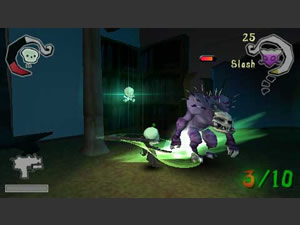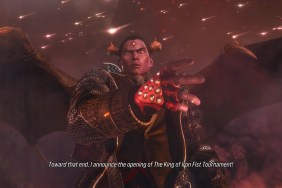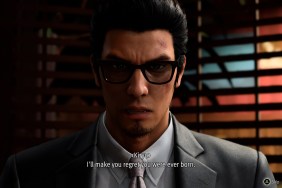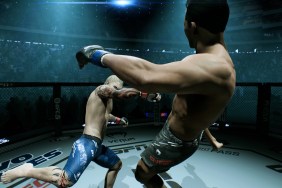Short-lived.
For a minute, place yourself in the moccasins of a game developer and imagine what it must have been like conceiving Death Jr. Starting with what we know: roughly 90% of pierced, tattooed, or otherwise scarred teens, in spite of their angst at everything in particular, would agree that The Angel of Death is cool. Now for the task at hand: if your job and perpetually growing belly demanded that it also had to sell to Wisconsin soccer moms so that angsty Timmy & Susie would play your product instead of Nintendogs, you would be wise to go with a theme somewhere in between elementary school and The Nightmare Before Christmas. Congratulations! You just made a mascot!
But it’s clearly tougher making a good game, as evidenced by the lackluster performance of this wee skeleton in his first outing.
We all know that the less sense something makes, the more it sells (Pet Rocks, Pokeballs, Richard Simmons, etc.), so it’s obvious that Death Jr. has star power runes all over it. It just would have helped if the kid got his interactive basics right.
Our hero starts off on a field trip to the Museum of Supernatural History. Along with his misshapen buds, DJ finds his own way through the museum’s winding halls to a roped-off area protecting an ancient artifact encased in a box. Pandora, a possessed doll and Death Jr.’s main squeeze, tries to open it up, but to no avail. Being the son of Death, DJ uses his trusty, super-sized scythe to rip the lock off “Pandora’s Box” in a “check me out, baby” maneuver, unleashing all types of hurt upon his friends. Now baby Death takes it upon himself to save the others in yet another desparate act of machismo.
Using the museum as a central hub that extends into multiple zones (each one themed for Death Jr.’s friends), you run through each level blasting anything you can lock your GTA-style targeting on while collecting power-ups and ammo, which is always abundant. All the while, you keep the killing machine fueled with successive hits on enemies or destructible objects, which rack up points in a braindead multiplier combo scheme. It’s not very sophisticated, though it gives an effective illusion that you are somehow getting a lot of things done.
This is entertaining for a bit, or at least until you realize that you score more and are a hell of a lot safer just blasting from a distance. This overly-simple winning strategy is, by its very nature, a repetitive one, and takes you about an hour to fully discover. It works quite well against the bosses, too, whose weak points are found through trial and error rather than being lit up, or heaven forbid, logically placed.
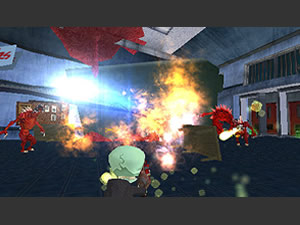 What will take a minute longer than eternity to get used to is the bad camera, which gives neither room nor time to move out of the way when an enemy reams you from offscreen. A couple of these frustrating whacks will make you leave your scythe to go gather dust, melee combo or no melee combo. After you strafe and blast away the baddies on one side of a floating platform and you’d like to turn around to clear the other side, Death Jr. will not cooperate for a good six seconds. You either have to keep moving back and forth for those six seconds (lest you fall off the platform) until he understands that it’s time to turn around now, go into first-person view and manually turn his head around, or trick the game by slashing the air behind you and then using the double-click L-trigger function to pop the camera back in place. Six seconds may not sound like much, but it’s just enough time to figure out which other game you’d rather be playing.
What will take a minute longer than eternity to get used to is the bad camera, which gives neither room nor time to move out of the way when an enemy reams you from offscreen. A couple of these frustrating whacks will make you leave your scythe to go gather dust, melee combo or no melee combo. After you strafe and blast away the baddies on one side of a floating platform and you’d like to turn around to clear the other side, Death Jr. will not cooperate for a good six seconds. You either have to keep moving back and forth for those six seconds (lest you fall off the platform) until he understands that it’s time to turn around now, go into first-person view and manually turn his head around, or trick the game by slashing the air behind you and then using the double-click L-trigger function to pop the camera back in place. Six seconds may not sound like much, but it’s just enough time to figure out which other game you’d rather be playing.
That better game could be a true third-person shooter, or even a platformer done right. The constant switching between either side of this gameplay sandwich makes Death Jr. feel erratic, since as soon as you’re getting into one, it will hurl you right back into the other.
Death Jr. graciously avoids the dreaded ‘collect 100 bananas’ trap by instead having you collect souls to advance through a level until you’re dumped back at the central hub. Same loop, different hook. Thankfully, the soul-bananas automatically come to you whenever an enemy is offed, which is a minor design decision in itself, but Death Jr. makes it feels like a major one. Another thoughtful little touch is a camera fly-by when you gain access to a section for the first time, so you’ll have some idea of where to go while getting treated to some nice visuals.
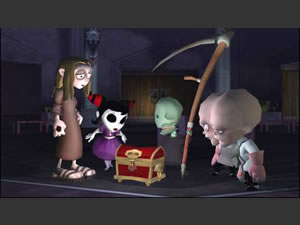 That, by the way, is the game’s finest feature. The environments and character design are genuinely cool, accompanied by some rather nicely stylized graphics and clean detailing, managing to be both vibrant and dark at the same time. Unfortunately, the focus on ranged fighting means you’ll be seeing enemies from too great a distance to appreciate them very much. Aside from the opening cutscenes, there isn’t too much to write home about other than some pretty particle effects here and there.
That, by the way, is the game’s finest feature. The environments and character design are genuinely cool, accompanied by some rather nicely stylized graphics and clean detailing, managing to be both vibrant and dark at the same time. Unfortunately, the focus on ranged fighting means you’ll be seeing enemies from too great a distance to appreciate them very much. Aside from the opening cutscenes, there isn’t too much to write home about other than some pretty particle effects here and there.
Far from the powerful compositions found in the films that inspired it, Death Jr.‘s music is comprised of short, childish Halloween loops given to each level. Its repetitive nature certainly matches the game’s feel, however.
It might sound like a new product for a new handheld, but you’ve actually been playing this game in your head ever since Mario went 3D back in the days when you thought giving him guns was genius. This is a tired, dull platformer that only manages to avoid the pitfalls of purgatory by way of its groovy style and decent character design. His dad might rule the underworld, but Death Jr.‘s repetitive gameplay keeps him stuck in limbo.
-
Tim Burton stylings
-
Some good action
-
Interrupted by a lame camera
-
Counter-productive melee combat
-
Repetitive ranged combat
-
Awkward platforming elements
